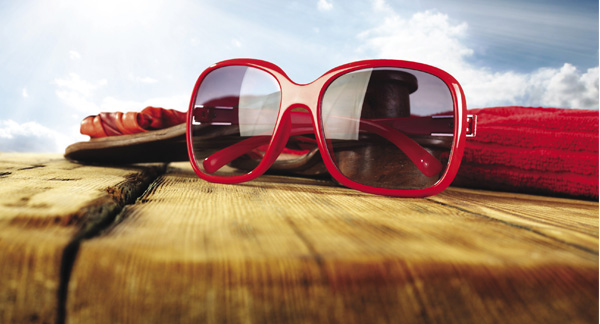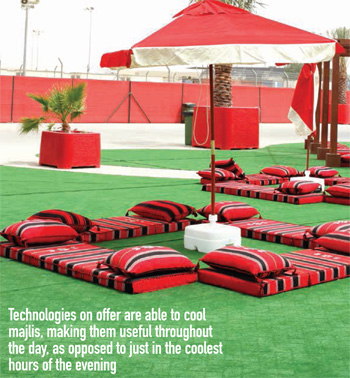With temperatures in the Middle East soaring to as high as 54°C during summer months, it doesn’t take rocket science to deduce that air conditioning systems are an absolute necessity in the region. There are certain cases, however, when employing traditional cooling methods makes less economic sense. We have the report.
With temperatures in the Middle East soaring to as high as 54°C during summer months, it doesn’t take rocket science to deduce that air conditioning systems are an absolute necessity in the region. There are certain cases, however, when employing traditional cooling methods makes less economic sense. We have the report.

Most the buildings, flats and villas in the Middle East have air conditioning units in place. Be they window units, ducted splits, chillers or VRF, these HVAC systems are a must in a region that experiences almost four months of extremely high temperatures and humidity. There are instances, however, when installing conventional HVAC systems may not be the right method to adopt for cooling. Take a patio for example. It will surely not be a good idea, cost-wise, to enclose it with glass or with concrete just to be able to use an air conditioning unit to cool it during summer.
Also, outdoor dining areas of restaurants are usually occupied by smokers and shisha users, and closing them off would not be a good move, health-wise. For these cases, when using traditional HVAC systems makes less sense, there are outdoor cooling technologies that promise to deliver a considerable amount of temperature decrease and may make occupants feel more comfortable.
“People throughout the Middle East love the outdoors, but it is too hot during half the year to truly enjoy yourself outside.” says Jonathan Marsh, CEO at MistAmerica. “With the right product that meets the needs of hotel, restaurant, and residential clients, the size of the market is quite large.” Marsh explains that outdoor cooling systems work like sea breeze: “They produce air that is more humid, but cooler. It is reasonable to expect a cooling level of about 3°C to 8°C in humid climates, like in Dubai or Abu Dhabi.” He adds that in drier climates, like in Riyadh or Al Ain, one can even expect a cooling benefit of up to 15°C.
Sam Peli, General Manager for European Sales, Seeley International, says that outdoor cooling technologies can contribute to maintaining healthy as well as a “traditional” lifestyle. “More exposure to outdoor activities may help fight problems, such as Vitamin D deficiency and obesity. These are quite common in the GCC,” he observes. He adds that utilising outdoor cooling technologies may prove beneficial to those people who would want to “preserve tradition”, as he believes that technologies on offer are able to cool majlis (Arabic, “a place for sitting”), making them useful throughout the day, as opposed to just in the coolest hours of the evening.
In terms of cooling capacity, Peli is of the opinion that through the continuous production of stream of fresh, filtered air, outdoor cooling systems, like evaporative cooling systems can manage to decrease the temperature by up to 35°C. “Temperature drop will vary through the day and through the seasons. In the worst conditions, we may see a 5°C to 10°C drop, or up to 35°C in the most favourable conditions,” he explains.
While outdoor cooling technologies find usual applications in residential patios or outdoor eating or relaxation places, larger capacity systems are increasingly being utilised for industrial applications. “With all the construction projects under way,” says Robert Mangiaforte, Director for International Sales at Port-A-Cool, “evaporative cooling can be used to create a safe working environment and increase worker comfort.” He explains that outdoor cooling solutions can be used in virtually any place where air conditioning is not available or is cost-prohibitive.
Growth areas
 Marsh and Mangiaforte agree that the Middle East is the foremost growth area for outdoor cooling technologies. From Marsh’s point of view, Qatar and Kuwait are excellent markets for his company’s Mist Cooling Systems. He explains: “Qatar is a good market, primarily because it is less humid there than Dubai. Kuwait is also an excellent prospect because the air there is dry, as it primarily comes from the desert.” Marsh reveals that the cooling benefits of Mist Cooling Technologies are maximised in dry conditions. He continues: “Every installation of our product is customised to the particular need of the area and the client. Through a site visit, we determine what needs to be done to cool an area, and whether our systems can truly add value to create a comfortable outdoor space.”
Marsh and Mangiaforte agree that the Middle East is the foremost growth area for outdoor cooling technologies. From Marsh’s point of view, Qatar and Kuwait are excellent markets for his company’s Mist Cooling Systems. He explains: “Qatar is a good market, primarily because it is less humid there than Dubai. Kuwait is also an excellent prospect because the air there is dry, as it primarily comes from the desert.” Marsh reveals that the cooling benefits of Mist Cooling Technologies are maximised in dry conditions. He continues: “Every installation of our product is customised to the particular need of the area and the client. Through a site visit, we determine what needs to be done to cool an area, and whether our systems can truly add value to create a comfortable outdoor space.”
Mangiaforte shares Marsh’s opinion: “In case of some of the big projects in Qatar and in the UAE, there is a real need for cooling during the construction phase and once the structures are ready. There is a big role in managing heat stress,” he says.
Throwing the spotlight on Qatar hosting the 2022 FIFA World Cup, Mangiaforte says that whether the games will be played during the summer or not, the comfort of the players and the spectators should be the focus.
MistAmerica and Port-A-Cool both have experience in providing cooling to stadia. Mangiaforte shares his thought: “The quality of the matches will be diminished if played in high-temperature conditions. We have had experience in cooling fans’ sections at Hamad Stadium and at Khalifa International Stadium in Qatar.”
Savings: A close look
 Outdoor cooling systems are usually employed when installing or using traditional HVAC technologies make less economic sense. Mangiaforte fleshes out this belief: “There is no question on the energy efficiency attributes of evaporative cooling. Traditional air conditioning is going to be 20% or 40% more costly than evaporative cooling.”
Outdoor cooling systems are usually employed when installing or using traditional HVAC technologies make less economic sense. Mangiaforte fleshes out this belief: “There is no question on the energy efficiency attributes of evaporative cooling. Traditional air conditioning is going to be 20% or 40% more costly than evaporative cooling.”
Mangiaforte shares the fact that most of his company’s units would work at AED 7 a day, and has a lesser carbon footprint compared to traditional systems. “Our end-users find it a very powerful proposition to use evaporative cooling as the cost-savings is huge,” he reveals.
Marsh delves deeper: “A typical outdoor patio space has 60 times the air exchange of an indoor space. In simplified terms, this means that one will need 60 times as much cooling outdoors as would be needed for the same square footage indoors. Clearly, an outdoor space with air conditioning systems is not feasible.” He says that if one were to partially enclose the area to lower the air exchange, one could find it more reasonable to cool the patio with an air conditioning system. “However, to save a significant amount on electrical usage, a properly designed outdoor cooling system using fan-driven high-pressure misting system will consume electricity at a small fraction of a traditional AC system.”
Chilling outdoors
Enduring extremely hot summer months is part of the experience of living in the Middle East. But keeping cool during this scorching season need not be expensive and energy intensive. Besides offering significant cost-savings to end-users, the purported energy efficiency of outdoor cooling technologies can help taper the energy demand during summer months, observed to peak owing to extensive use of air conditioning systems. When installing air conditioning systems is not the most cost-efficient choice, one could have a look at the outdoor cooling systems available on offer.
| On water consumption and health issues Jonathan Marsh, CEO at MistAmerica, and Sam Peli, General Manager for European Sales at Seeley International, shed light on the water consumption of outdoor cooling systems and health-related concerns surrounding their operations from the point of view of their companies. Highlights…Marsh: “Water consumption is minimal. Remember, evaporating just under six litres/hour dissipates as much heat as a one-tonne air conditioner. There are several different nozzle orifice sizes, but a typical humid-climate nozzle will use 0.04 litres/minute. Health issues are important to address with all types of cooling systems, as we are breathing this air. Our outdoor cooling systems do not involve any ‘changing’ of the water. A typical system is tied into a building’s potable water lines, and then filtered via reverse osmosis (RO) water treatment. We normally use a closed system RO with no holding tank – so we minimise any chance for bacterial buildup. In addition, we will treat the water for bacterial growth with UV light and chemical injection systems where needed or desired.”Peli: “There would be water consumption involved in outdoor cooling systems, but from an environmental point of view, that would be much preferable compared to high energy usage and presence of refrigerant gases that pose a threat to the environment. Typical water usage would be below 1 litre/hour per kW of cooling.“Whereas old style ‘desert coolers’ may pose health issues, the latest generation products are totally safe from this point of view. Water would be automatically monitored and discharged to avoid proliferation of bacteria. The whole system – tank, pads, pump, fan – is designed to avoid stagnation of water when the system is not in use, as well as any presence of air droplets in the air-stream. Air droplets are the main threat, as they are the only medium that may carry contaminants. Note that vapour (evaporated water) does not carry contaminants. Indirect systems are even inherently safer as the air flow doesn’t come into contact with the water at any time.” |
Copyright © 2006-2025 - CPI Industry. All rights reserved.